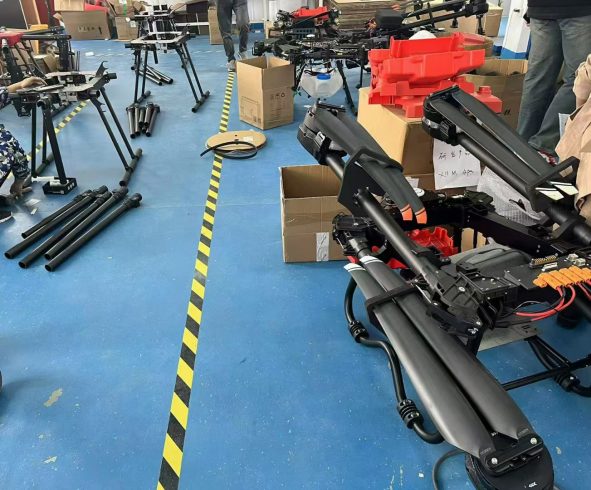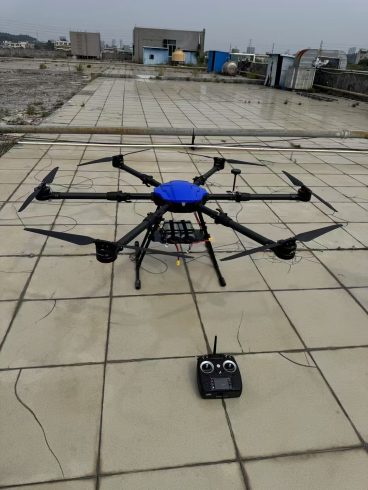![图片[1]-High-Payload Drones for Spraying: Revolutionizing Large-Scale Agriculture-msoen](https://www.msoen.com/wp-content/uploads/2025/04/4dd27bd528215007-768x1024.jpg)
As farms expand and the demand for efficient crop management grows, high-payload drones are emerging as critical tools in modern agriculture. These advanced drones, capable of carrying significant volumes of pesticides, fertilizers, or herbicides, are transforming how farmers tackle large-scale spraying operations. This article explores the benefits, challenges, and applications of high-payload spraying drones, helping you understand why they’re becoming indispensable for precision farming.
What Are High-Payload Spraying Drones?
High-payload spraying drones are specialized unmanned aerial vehicles (UAVs) designed to carry and disperse large quantities of agrochemicals. Unlike standard agricultural drones, which typically hold 5–20 liters, high-payload models can transport 20–50+ liters of liquid per flight. Built with robust frames, powerful propulsion systems, and advanced spraying mechanisms, these drones balance capacity, efficiency, and precision.
Why Payload Capacity Matters in Agricultural Spraying
Payload capacity directly impacts operational efficiency. Larger payloads mean:
- Fewer Refills: Reduced downtime for reloading chemicals, enabling faster coverage of expansive fields.
- Lower Operational Costs: Fewer battery swaps or refueling cycles save time and labor.
- Scalability: Suitable for large farms (100+ acres) or cooperative farming projects.
- Consistency: Uniform chemical distribution over vast areas improves crop health.
Key Benefits of High-Payload Spraying Drones
- Enhanced Efficiency for Large-Scale Farms
High-payload drones excel in covering hundreds of acres daily. For example, a drone carrying 40 liters can spray 15–20 acres per hour, depending on crop density and flight speed. This efficiency is unmatched by traditional methods like tractor sprayers, which face challenges in wet or uneven terrain. - Precision Spraying Technology
Modern high-payload drones integrate GPS mapping, LiDAR, and AI-driven systems to:
- Create detailed field maps.
- Adjust spray rates based on real-time plant health data.
- Avoid overlapping or missing sections, reducing chemical waste by up to 30%.
- Accessibility in Challenging Terrain
From flooded rice paddies to steep vineyards, these drones operate where ground machinery cannot. Their aerial approach minimizes soil compaction and crop damage. - Eco-Friendly Farming
Targeted spraying reduces chemical runoff, protecting nearby water sources and ecosystems. Electric models also lower carbon footprints compared to fuel-dependent alternatives. - Cost-Effectiveness Over Time
While initial investments are higher than smaller drones, high-payload models offer long-term savings through reduced labor, fuel, and chemical costs.
Challenges of High-Payload Spraying Drones
- Higher Upfront Costs
Advanced components like heavy-lift motors, dual spraying nozzles, and reinforced frames increase purchase prices. However, ROI improves with scale. - Regulatory Compliance
In many regions, operating heavy drones requires certifications, insurance, and adherence to aviation regulations. Pilots may need specialized training. - Battery Life Limitations
Electric drones face trade-offs between payload and flight time. Carrying 50 liters may reduce flight duration to 15–25 minutes, necessitating multiple batteries for large jobs. - Weather Dependency
While more stable than smaller drones, high winds or heavy rain can still disrupt operations.
Applications of High-Payload Drones in Agriculture
- Broad-Acre Crops: Ideal for wheat, corn, soybeans, and other row crops requiring uniform coverage.
- Orchards and Vineyards: Navigate tight rows and steep slopes while protecting delicate fruit.
- Emergency Pest Control: Rapid response to locust swarms or disease outbreaks.
- Liquid Fertilizer Application: Precise micronutrient delivery to boost soil health.
Future Trends in High-Payload Drone Technology
- Hybrid Power Systems: Combining gas engines with electric motors to extend flight times.
- Swarm Technology: Deploying fleets of drones synchronized via AI for massive-scale operations.
- Improved Battery Tech: Higher energy density batteries to balance payload and endurance.
- Autonomous Charging Stations: Self-landing docks for continuous, unmanned operations.
Choosing the Right High-Payload Drone
Consider these factors:
- Farm Size: 100+ acres benefit most from 30–50L payloads.
- Crop Type: Dense crops (e.g., sugarcane) may require higher spray rates.
- Budget: Evaluate long-term savings versus upfront costs.
- Local Regulations: Ensure compliance with weight and licensing rules.
Conclusion
High-payload spraying drones represent the future of large-scale precision agriculture. By combining unmatched efficiency, cutting-edge technology, and environmental benefits, they empower farmers to meet the growing demands of global food production. While challenges like cost and regulations exist, the long-term advantages—reduced waste, higher yields, and scalability—make them a worthy investment for progressive farming operations.
As drone technology evolves, expect payload capacities and autonomy to improve further, solidifying their role as essential tools in sustainable agriculture.
SEO Keywords: high-payload spraying drones, agricultural drones for large farms, crop spraying drone technology, heavy-lift agricultural drones, precision farming drones, best spraying drones for agriculture, high-capacity crop drones, eco-friendly farm drones.
Meta Description: Discover how high-payload spraying drones enhance efficiency and precision in large-scale agriculture. Learn benefits, challenges, and future trends for modern farming.











暂无评论内容